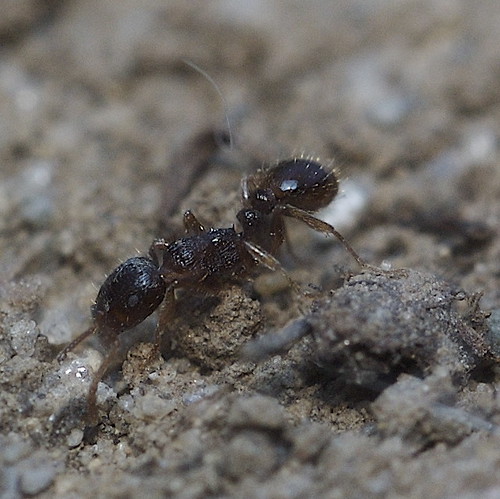Here's a photos of a small ant I took today. It turned out quite well, much better than with my previous non-SLR camera, but it points to a few things I'll be working on with my macro photography.
One of these macro issues I've just found out about is diffaction effects at small aperture settings. Here's a great article on the subject. Wikipedia has a nice article on part of the theory behind the issue. Essentially, the smaller the aperture allowing light to pass from the lens to the sensor or film, the more likely individual waves of light are to overlap with each other, creating fuzziness in the image. Other variables involved include the size of the sensor, the size of the individual sensor receptors, and the focal distance. Of course, the quality of the lens passing light to the sensor is an important factor as well. People say that one should be able to take good photos no matter what equipment one is using. This is true to a certain extent, of course. I am very happy with many photos taken with my previous non-SLR camera. However, smaller sensor size, smaller aperture, less sharp optics, and the inability to use flash made getting a sharp picture more difficult. The page I linked to above has a nice calculator that lets you figure out how small you can set your camera's aperture before diffaction effects manifest themselves. My camera at macro focal distance apparently can be set up to f14 or f16.
Availability of light is another issue with any photography. For my macro photographs when not in bright sunlight I've started to use my on-camera flash with a homemade diffuser at the end of the lens cut from a vinegar bottle. Unfortunately, with flash, the camera seems to want to set shutter speed to 1/60 second. At this speed motion blur can be an issue. I will try experimenting with setting ISO level to 400 or 800, seeing what using a wider aperture does, and when I am confident enough, setting shutter speed manually as well.
Another always-present issue with macro photography is the very shallow depth of focus one must deal with, also known as depth-of-field. Another nice page on the diffraction effects site (cambridgecolour.com) deals with depth-of-field. A nice calculator is included on this page as well that allows depth-of-field for varying focal lengths, subject distances, apertures, and camera sensor sizes to be estimated. At f16 I should get about a 5mm depth-of-field. At f14 I should get about 4.5mm. This means that taking a photo head-on of a 7mm ant at most 4 to 5 mm of the subject will be in sharp focus. Focusing at such close distances is tricky, so one often gets a situation where sharp focus begins a bit in front of the subject, so one might only get 2 or 3 mm of sharp focus. This explains why one sees lots of side-shots or top-shots of macro subjects. The area of interest all falls within the depth-of-field focal range for these shots.
